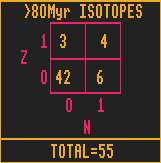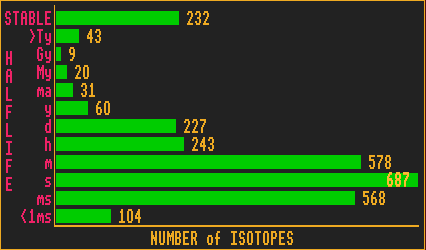



The bottom chart shows the number of nuclides with halflives that fall within a particular band. Thus there are 225 nuclides with halflives between 1 day and 1 year.
Of the 3014 known Isotopes in the year 2000 AD, there are 232 Stable Isotopes, and 2782 Unstable ones. From the 318 isotopes of the 84 elements found in nature 232 are stable, the other 86 are radioactive with half-lives greater than 80 million years.
There are theoretically approximately 7000 nuclei allowed by the laws of ohysics. This is a lot smaller than the maximum proton number (about 120) multiplied by the maximum neutron number (about 180) [which gives about 21,600 nuclides].
As there become more and more isotopes discovered at higher and higher energies, there will be more and more with ever shorter halflives.
![]()